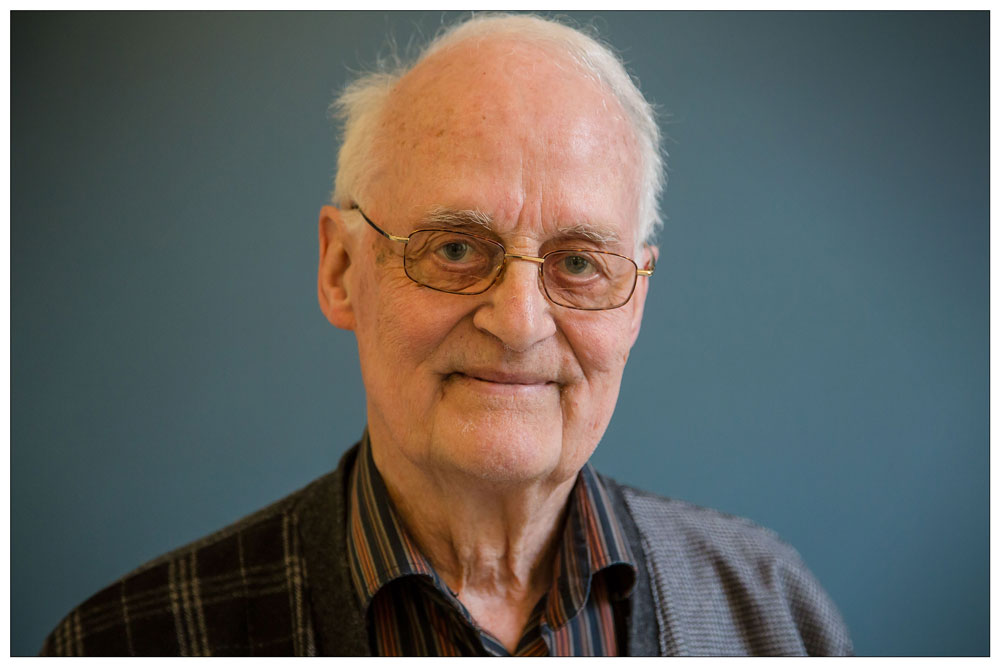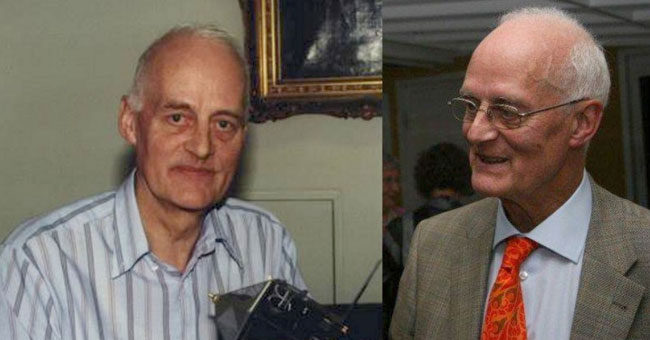Erik Høg: A life serving Astrometry and mapping of the Universe
This is an overview of my scientific work from 1950-2021.
My research was focused on development and work with meridian circles from 1953 to 1975. From 1975 I worked on satellite astrometry and photometry, that is to design new, more powerful instruments for astrometry and photometry from space and to take part in the development and exploitation of astrometric satellites. An overview of my scientific activities for 1950-2021 is given, in Danish and English, often from the website of the institute.
After retiring in 2002, I have taken increasing interest in the history of these subjects and in giving public presentations on astronomy.

My research has mainly been on astrometry since I was a 21 year student in 1953 in Copenhagen. Astrometry is the observation of positions, motions and distances of stars.
My tutor Peter Naur introduced me to electronics and computer sciences, then new disciplines for astronomers, and this led me to focus on improvement of the astrometric foundation of astronomy.
In 1960 I designed a new astrometric method by photon counting. This was basis for the first astrometric satellite Hipparcos on which I worked 1975-2000. Astrometric data from the current Gaia satellite launched in 2013 are revolutionizing astronomy in all branches. Since 2013 I am working on a Gaia successor which ought to be launchd hopefully about 2035.

Recent presentations of my work and the development of astrometry during two thousand years are given in connection with the prize from the Astronomische Gesellschaft received in 2019, cf. the following section with publications.
Surveying the sky
My scientific work during 50 years written about 2011, appears on the website of the Niels Bohr Institute at https://www.nbi.ku.dk/english/www/astrometry/surveying/
Emeritus, associate professor, dr. scient.
Address: Niels Bohr Institute
Blegdamsvej 17, 2100 Copenhagen Ø, Denmark
Email: ehoeg@hotmail.dk
Phone: +45 6170 6129
Erik Høg born 17.6.1932, Student at Copenhagen University 1950–1956, at Hamburg Observatory 1958–1973, Hauptobservator, Dr. scient., associate professor, Copenhagen, University Observatory, 1973–2002, emeritus 2002 at the Niels Bohr Institute. Guest professor:
- Tokyo Astronomical Observatory for two months, 1982; 2. Astronomisches Institut der Universität Tübingen for a year, 1987/88; 3. Observatoire Astronomique de Strasbourg for a month in 1990 and again in 1991. Member of the Astronomische Gesellschaft since 1958, and of the International Astronomical Union since 1961. Member of the Astronomy Working Group of ESA 1976–1879. President of the Commission for Positional Astronomy of the International Astronomical Union (IAU) 1979-1982.
Scientific work on high precision astrometry
The measurement of positions, motions and distances of stars. Design of new astrometric instrumentation, taking the astrophysical applications into account, especially by inclusion of photometry. Instrument development, observations, production of catalogues. Initiation of astrophysical utilizations.
Photoelectric astrometry and photometry
Designed in 1960 the first astrometric slit system with photon counting, a basic measurement technique used for astrometry and photometry in modern meridian circles and in the Hipparcos and Tycho space missions. Equiped the Hamburg meridian circle 1960–1967 with a photon counting micrometer and semi-automatic control. This instrument was used in Perth, Western Australia, by the Hamburg expedition 1967–1972. Produced and published in 1976 the resulting catalogue, Perth70, with positions of 24,900 stars. Timing of the optical Crab pulsar was made by a student in Hamburg with my photoelectric equipment during many years, beginning in October 1970 this was the first timing observations of an optical pulsar in Europe.
Space astrometry and photometry
Presented in 1975 seven basic ideas for an astrometry satellite which were crucial for the design of Hipparcos. Proposed in 1981 a new experiment, Tycho, for the Hipparcos satellite, resulting in the Tycho Catalogue with astrometric and photometric results for a million stars. Member of the Hipparcos Science Team. Leader of the Northern Data Analysis Consortium for Hipparcos 1982–1990. Leader of the Tycho Data Analysis Consortium 1983–1997. Designed in 1992 a new astrometric and photometric satellite mission, Roemer, based on the use of CCDs in direct imaging and time-delayed integration. It would be at least 100,000 times more efficient in the use of starlight for astrometry than the Hipparcos-Tycho mission.
Designed in 1995 a new optical system for the ESA mission Gaia, using interferometric techniques. This optical design was basis for the planned German astrometric satellite mission DIVA. Member of the Science Advisory Team 1997–2000 for the cornerstone mission Gaia, approved by ESA in 2000. Member of the Gaia Science Team 2000–2007.
Contributions especially to the sampling, detection and imaging with Gaia and to the definition and implementation of photometry with Gaia. Leader of the Gaia Photometry Working Group 2000–2005.
Publications
Author or coauthor of 185 numbered technical reports for Gaia and many unnumbered 1997–2007. Showed theoretically (1995) that simultaneous astrometric and photometric observations, e. g. with an astrometric satellite, of a microlensing event (a MACHO) can provide the proper motion, the distance and the mass of the dark object. During 1996–2000 work on a new reduction of all Tycho observations from the Hipparcos satellite which resulted in the Tycho-2 Catalogue of positions, proper motions and two-colour photometry for 2.5 million stars, published in 2000.
Awards
- In May 1999 The Director of Science Medal from the European Space Agency For Outstanding Contribution to the Science Programme. An asteroide was in 2005 named Erikhøg by the IAU.
- In 2009 the commemorative medal after F. G. W. Struve – founder and first director of the Central Astronomical Observatory of the Russian Academy of Sciences in Pulkovo, Russia – was awarded for the great contribution to development of ground-based and space astrometry.
- In 2014 Honorary doctor at Main Astronomical Observatory of the National Academy of Sciences of Ukraine, Kiev.
- In September 2019 The Instrument Development Prize from the Astronomische Gesellschaft.
- 2023, Honorary Fellowship of the Royal Astronomical Society. London, UK
In a distinguished career over nearly seven decades, Professor Erik Høg has played a prominent role in moving the fundamental discipline of astrometry into the space age, generating many scientific advances.
Some 200 publications in scientific journals and books, cf. the following section.
A search on 2021.04.10 in ADS with author:"høg, e" returns 269 results from 1960-2021. They do not include, e.g., four historical papers in Nuncius Hamburgensis, but they are available in arXiv.
Some recent publications are listed hereafter. More details are given in the following "List of my papers since 2006" from 2021.
Høg E. 2018, Das Alter der Welt. In German 6 pages. In: Sterne und Weltraum, Oktober 2018, Welt der Wissenshaft: Essay. Available at https://www.astro.ku.dk/~erik/xx/AlterDerWelt.pdf
Høg, E. 2019, Instrument Development Prize from the Astronomische Gesellschaft. The prize for 2019 was awarded to Lennart Lindegren, Michael Perryman and Erik Høg at the annual meeting of the AG in Stuttgart: https://www.astro.ku.dk/~erik/xx/InstrumentPrize2019Award.pdf
The Niels Bohr Institute informs on 19 September 2019: https://www.nbi.ku.dk/english/namely_names/2019/erik-hoeg-receives-prestigeous-scientific-prize-for-a-lifelong-commitment-to-measuring-the-universe/
Høg E. 2019, Astrometric accuracy during the past 2000 years. The development of astrometric accuracy since the observations by Hipparchus, about 150 B.C., has been tremendous and is here shown in a new simplified diagram: https://www.astro.ku.dk/~erik/xx/Accuracy2019.pdf Placed on arXiv at: https://arxiv.org/abs/1707.01020
Høg E. 2019, The road from meridian circles to Gaia and beyond. Abstract of seminar to be held in 2020 and information on a Gaia successor with international participation: https://www.astro.ku.dk/~erik/xx/MCtoGaiaAbstract.pdf
McArthur, B., Hobbs, D., Høg, E., Makarov, V., Sozzetti, A., Brown, A., and 17 coauthors 2019, All-Sky Near Infrared Space Astrometry. White Paper to the National Academy of Sciences (NAS) Committee for Decadal Survey on Astronomy and Astrophysics 2020 (Astro2020), 7 pp at https://arxiv.org/abs/1904.08836 and https://www.astro.ku.dk/~erik/xx/WhitePaperNIRSpaceAstrometry.pdf
Høg, E., Hobbs, D. 2019, Gaia Successor with International Participation. Abstract of a talk submitted to Annual Danish Astronomy Meeting on May 2-3. Available at https://www.astro.ku.dk/~erik/xx/GaiaSucTalk.pdf
Hobbs D., Brown A., Høg E., ... Vaccari M (30 authors) 2021, All-sky visible and near infrared space astrometry. In: Experimental Astronomy, 61 pp At: https://doi.org/10.1007/s10686-021-09705-z or as a PDF here: https://link.springer.com/content/pdf/10.1007/s10686-021-09705-z.pdf
Høg E. 2021, The road from meridian circles to Gaia and beyond. A seminar held online at the universities in Potsdam and Perth. The abstract: https://www.astro.ku.dk/~erik/xx/MCtoGaiaAbstract2021.pdf The slides with references to documentation, and a new slide at the end: https://www.astro.ku.dk/~erik/xx/MCtoGaiaPotsdamPerth2021.pdf , recording from the talk in Perth, introduction by Andreas Wicenec + talk + questions = 4+48+4 minutes: https://www.dropbox.com/s/e9z1qcikojc7s86/Erik_H%C3%B8g_ICRAR-UWA_16_03_21.mp4?dl=0
Høg E. 2021, List of my papers since 2006. 11 pp. https://www.astro.ku.dk/~erik/xx/arXivHoeg.pdf

